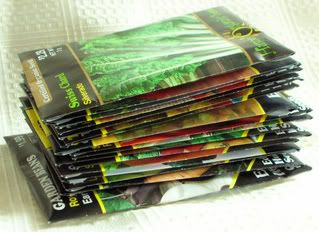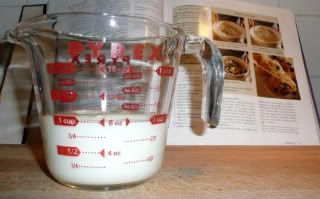The bike is a super duper, shine-y, silver one. I was 18 the last time I got a new bike, a Huffy that weighed a ton.
Doing our best to eat locally and sustainably, raising our own food on a small lot in the city, making hand-crafted cuisine, and keeping it real.
Tuesday, March 30, 2010
New bike! New office! New life!
The bike is a super duper, shine-y, silver one. I was 18 the last time I got a new bike, a Huffy that weighed a ton.
Saturday, March 27, 2010
Justification
I remember having seen artichoke starts. There were none left. There was this weird gravitational pull toward a rack of Ed Hume seeds. These are seeds designed for the Pacific Northwest's climate. Score!
Suddenly, these "Cosmic Purple" carrots were in my hand. Then the orange carrots. Oh, and parsnip seeds! I love parsnips.
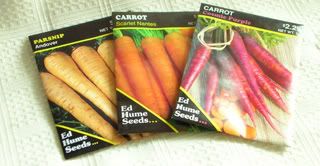
Whoa. Check out the tomatoes. "Oregon Spring" was designed for the cooler climate here and has a quick maturity cycle. Nice! And here's a good mix of heirloom tomatoes that will mature at different times. Aren't they pretty? Check out those colors. Don't my summer canning recipes call for Romas? Those did well last summer. I should grab some more.
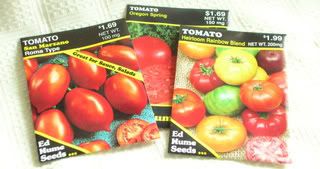
Next, I called Gene. I can't remember: did he like radishes? No? OK good, me neither. Did he want anything? Lettuce: check. Oh, look cabbage! Gene loves homemade sauerkraut so I'll get that. Chard is so yummy in stir-fry and it's still early enough to start some.
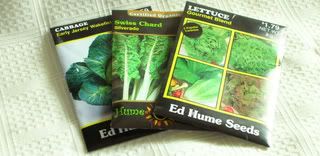
Gene said that he wanted broccoli and beans. Pretty! Purple! Beans! Whu wait... ohhh, leeks! Gene doesn't like those but I do and they're expensive. Last year's tomatillos did well, so I should pick up more. And artichokes for sure. I'll start those in the house right away and plant those out front, too.
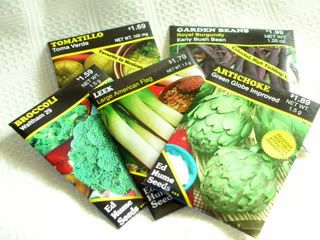
Oh man... I hate paying for parsley and cilantro in the summer. The cilantro will be tasty in a salsa verde. And the basil will get planted in the new raised beds Gene said this morning that he'll build for me. Yeah yeah. Homemade pesto! I'll make a huge batch and freeze it in ice cube trays.
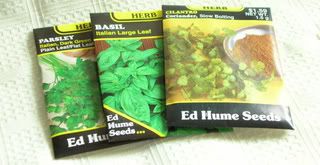
I fondled the celery and spinach packets but remembered that I had some celery seeds at home. The only spinach seeds are hybrids, and since I'm going to try to save my own seeds this fall I returned the spinach to the rack. Hybrid plants don't produce reliable offspring from their seeds.
Dreaming of how my garden will grow, I drove home.
Where I discovered these:
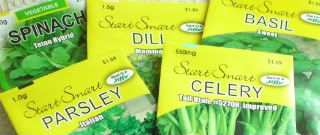
Friday, March 26, 2010
Many little seeds are planted
And so my knee-jerk reaction is "Heck, no, we weren't like that! This is an interest that has developed since I became an adult."
Upon deeper reflection, though, there are lots of factors from my childhood that contribute to my interest in and appreciation for local food.
Every summer my family headed for Puyallup to get a bucket of blueberries, which we would freeze and enjoy all winter. We ate blueberries in everything: pancakes, muffins, fruit salads, Jello (my mom has an inexplicable fetish, but no aptitude, for Jello molds), and on a rare occasion one of my favorites: blueberries and dumplings.
One summer we went to my folks' favorite blueberry farm only to discover that the farmer had sold out. The decades-old bushes had been razed and in their place was a housing development.
Other childhood memories of local food include watching my grandpa fuss over his tomatoes, going with my parents to purchase whole salmon from friends who had caught it, clam-digging (and horrible sunburns), visiting pumpkin patches, picking berries with friends in vacant lots, and the smell of skunks as we headed to Duris Farm for cucumbers. My nostrils still twitch in memory of dead skunks any time I head through Puyallup.
According to my grandma, her mother kept chickens no matter where she lived, and held them in the same regard I do.
When I was an exchange student living in France, I fell in love with the street markets. Whenever my schedule allowed, I loved to wander the stalls, fingering the produce, smelling the flowers and cheeses, watching the shoppers, dickering with vendors, and planning ways to prepare my bounty.
I'm not a great gardener. But I keep trying, I keep experimenting, and I keep growing.
This morning I inspected my pea patch and am pleased to see them just starting to break through the soil. My raspberries, which the next-door landlord ruined last summer, are showing proof of recovery. The hens have laid 3 eggs thus far, and I bet there will be more later. Yesterday's rains watered my new strawberry and asparagus deeply.
From blueberries to salmon, clams to tomatoes, I guess I've known all along where I got my roots.
Where does your passion for local food come from?
Monday, March 22, 2010
Homemade vs. Local
What I'm struggling with right now:
- When does something that's homemade or homegrown count as local?
- Does local mean it has to be homemade?
CASE #1
Last weekend I bought a whole bunch of bagged starts at Lowe's on clearance. I came home with rhubarb starts, onion sets, blueberry plants, and seed potatoes.
The likelihood that they're all from the Pacific Northwest is pretty dim. But the food they'll produce will come from my own yard. Rhubarb is a perennial, and I plan to keep my own seeds from here onward.
Local or not?
CASE #2
Gene and I went out for dinner tonight to celebrate my new job in Tacoma. I wanted a juicy burger and some kick-ass fries. We ruled out Red Robin because it's a national chain, and opted for The Ram because it's a family-owned local* chain and has a water view.
I decided against the Parkway Tavern because they don't have fries (though their burgers are among the best I've ever had). Didn't go to Katie Downs because I think they're overpriced, and I didn't feel like trying to find a table with a view in The Spar's teensy back room.
I totally spaced about The Harmon until it was too late. DOH!
The Ram's fries lived up to expectations but nothing else did. What a disappointment. I felt like we should have known better. I also felt like we should have taken our $30 and spent it on a really great cut of meat or seafood at Met Mart.
Does local mean it has to be homemade?
*I thought that The Ram is a small chain of sports bars in Washington's Puget Sound region. Turns out they have 17 restaurants across 5 states.
Sunday, March 21, 2010
Not-so-strange Bedfellows
My house, like many in Tacoma, has a steep grassy slope coming up from the sidewalk to the flat part where the house sits. When I used to mow it I would have terrifying mental images of slipping under the blades. I couldn't afford a retaining wall but had to do something about that grass.
One winter I smothered the grass with newspapers and Tagro, collected starts from friends' gardens, and created a flower bed on the slope. After several years of maintaining this bed, the truth is that slope never really was the gorgeous array of drought-tolerant plants that I had envisioned. It looked pretty and lush in the spring but by the end of summer it was, frankly, an eyesore.
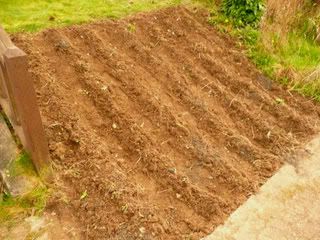 I've been thinking for a while about what to do with this bed. The backyard has no more space for gardens, is overrun by chickens, and is pretty shady. My efforts to grow more of our own food in our little yard gave me the perfect excuse to rip out the failed garden.
I've been thinking for a while about what to do with this bed. The backyard has no more space for gardens, is overrun by chickens, and is pretty shady. My efforts to grow more of our own food in our little yard gave me the perfect excuse to rip out the failed garden. Yesterday I pulled up half of one side. Most of the plants went into the yard waste bin. The things I want to keep will get transplanted elsewhere in the yard.
At one point I started to think about how asparagus, a tall plant that is harvested in May, and strawberries, a short plant harvested in June, might layer in the bed. Turns out that my intuition was right. Googling "asparagus and strawberries" resulted in lots of articles about companion plantings.
After a long afternoon of hard labor, I now have the asparagus bed I've wanted since reading about them in Animal, Vegetable, Miracle. As an added bonus, I also have strawberries.
My 4-year-old neighbor informed me that she can't wait to eat all my strawberries. God help me, I'm going to turn into that cranky lady who sits on the front porch and yells at the kids to get out of her gawd-fer-sakin' yard.
Thursday, March 18, 2010
Sometimes 35 miles just isn't local enough
Consider:
12.5 hours per week x 48 weeks per year x 4.25 years = 2550 hours
2550 hours = 106.25 days = 3.42 months
It pains me to do that math and see that in the past 4+ years, I have spent over 3 entire months on a bus.
 I learned to knit on the bus. This is what Seattle looks like for me on many mornings. My fellow commuters taught me the basics. A woman my husband has since dubbed The Uber Knitter gave me pointers, tips, patterns, and careful critiques: "well, you could keep going like this but I don't think that you're going to be happy with the finished project". My knitting projects progressed from crooked scarves to more complicated projects like fingerless gloves for my brother and baby attire for my many fertile friends.
I learned to knit on the bus. This is what Seattle looks like for me on many mornings. My fellow commuters taught me the basics. A woman my husband has since dubbed The Uber Knitter gave me pointers, tips, patterns, and careful critiques: "well, you could keep going like this but I don't think that you're going to be happy with the finished project". My knitting projects progressed from crooked scarves to more complicated projects like fingerless gloves for my brother and baby attire for my many fertile friends.Turn, turn, turn
There is a season - turn, turn, turn
And a time for every purpose under heaven
A time to be born, a time to die
A time to plant, a time to reap
 This is the first of a monthly series about what's in season now.
This is the first of a monthly series about what's in season now.
When we think about eating locally and seasonally, we usually imagine produce. But in reality, nearly all foods have a season: meat, seafood, even eggs. The eggs our chickens lay vary widely in color and production throughout the year.
Here's what's in season for late March in Western Washington. Please don't hesitate to add to and correct this list. I'm learning, too!
PRODUCE (from http://www.nrdc.org/health/foodmiles)
- From the fall crop: apples, pears, winter squash, potatoes
- Root vegetables (most from fall crops): carrots, onions, garlic
- Hearty greens: chard, kale, collards
Dandelions are also in season. Pick the tender leaver now before the plants' flower stalks emerge. The leaves are delicious with a warm mustard and bacon dressing and a hard-boiled egg. I ate dandelion leaves often as a poor exchange student in France. Check out this link for info about nutrition and preparation.
MUSHROOMS
I have friends who go mushroom hunting, something I've never done. I've never loved mushrooms but would be interested in learning more about it. Get info at the Puget Sound Mycological Society's website.
SEAFOOD (from Icicle Seafoods, Inc. and Seafood Producers' Cooperative)
Because wild fish don't hold still, I included fish caught off the coasts of Washington, British Columbia, and Alaska for the purposes of this list.
- Razor clams - season dates and locations
- Some Alaskan salmon, look for sustainable and wild-caught
- Halibut, sablefish, and black cod (March to November)
- King salmon
FLOWERS
This time of year in the Pacific Northwest, it's all about the daffodils, baby! Yesterday I bought 60 daffodils for a mere 6 bucks. The daffs are from the Puyallup Valley, just miles from our house. The buds were tightly closed and green yesterday. Today, as you can see, they are beginning to turn yellow and open. They make my heart happy.
Tulips are also in stores but they're still a bit early. Grab handfuls of daffodils now and wait for the tulips.
MEAT (from Eat the Seasons, a British website but included because of similarity of climate)
- Lamb
- Rabbit
Personally, I love rabbit and lamb. Get over the Disney-fication of these animals. They're delicious and they're in season now.
Sunday, March 14, 2010
Ohhhhh, muck!
The girls are funny, inquisitive, silly, and attentive. They follow us around the yard, sit on our laps, and pull at our pant legs until we pick them up. They crack us up with their antics and break our hearts when they leave this world.

Not to mention that hens are probably the only pet that pays "rent". Right now we're getting over 3 dozen eggs each week from our 9 girls. If I sell just 4 dozen eggs a month, it pays for the 50 lbs of feed they'll eat during that time. I don't want to go near the things our cats produce.

In the 2 years we've had chickens, the only food scraps that I've thrown into the garbage disposal are things in the citrus and onion families. Everything else - moldy cheese and bread, fruit and vegetable peels, leftovers retrieved on archaelogical missions to the farthest corner of the fridge - goes to the 9 walking stomachs.
They're pretty good for the garden, eating dandelions and pooping out fertilizer.
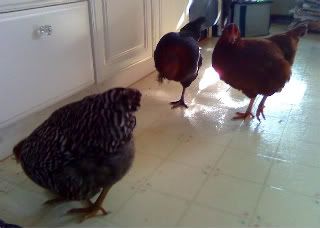
Because all of the girls were brooded in the house, our girls are very friendly and have no qualms about sneaking into the house any chance they get. The house is, after all, the People Coop. Last fall I hosted a baby shower and the guests were entertained by a surprise appearance by Curry when I was distracted: brrrrrawwwwk!
Remarkably, the chickens rarely poop during their visits.
Keeping hens in the city on a small lot definitely has its disadvantages.
Unfortunately, having the world as their buffet means everything in the yard is on the menu. My red-twig dogwood and Japanese maple have no leaves below 2 feet. The sole plants the yard sharks haven't nibbled to nothingness are the hydrangeas and the columbine, and it's not for lack of trying. We're limited on where we can put their run so last fall I spent a lot of time transplanting plants out of it to other areas of the yard.
They also love to steal whatever you're eating. Dining al fresco can be like that seagull scene in Finding Nemo. "mine mine mine... mine?"
I laugh when people ask about grass. What grass? And with no grass, our backyard becomes a quagmire of muck when it rains... which is about November to April here. We've adopted a no-shoes rule in the house because of the muck.
All chickens have a weird obsession with styrofoam. They've eaten a faucet cover, pecked out the spray foam insulation next to the back door, and demolished the lid to a styrofoam ice chest. Grrrr.
And don't get me started on their digging. They love to dig more than any dog. What plants they don't dig up or eat, they trample.
So, we've given up. Last summer we created the "No Chicken Zone", aka "The NCZ". The wire fencing keeps them out of the house, off the back porch and carport, away from the vegetable garden, and prevents their general destruction of the other half of the yard.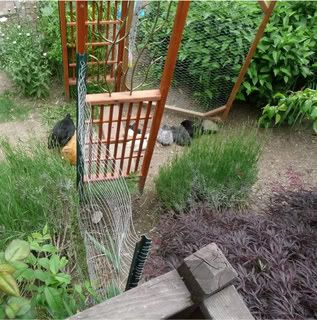
The problems we must address this spring are:
- increasing drainage in their area by installing a French drain
- keeping the summer fly population down; last year's fly paper didn't do the trick. I'm even considering getting fly predators.
- finding a way to get grass to grow without it being utterly destroyed within 3 days
- figuring out more plants that are unpalatable to chickens and that can survive the harsh conditions in their run
Be forewared: if you decide to get chickens your yard and life will be forever changed.
Saturday, March 13, 2010
The ingredients of a perfect weekend morning
 I tend to be an early riser on weekends, up normally by 7 or 7:30. Today I was up before 6:30.
I tend to be an early riser on weekends, up normally by 7 or 7:30. Today I was up before 6:30. 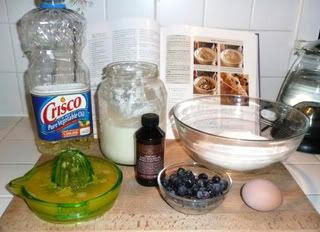 recipe from Cooking Light's "Complete Cookbook" published in 2000. It's my go-to cookbook for ideas, tips, methods, and even recipes.
recipe from Cooking Light's "Complete Cookbook" published in 2000. It's my go-to cookbook for ideas, tips, methods, and even recipes. What I love about this recipe, besides the fact that it's a cinch to make and the end result isn't cake-sweet, is that it's really flexible.
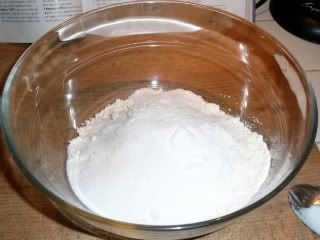 You just need something acidic to activate the baking powder and soda.
You just need something acidic to activate the baking powder and soda.I make yogurt a half gallon at a time, so you can imagine that I'm glad to find recipes that call for this much yogurt.
Since I can't be bothered with getting another bowl dirty, I just combined the rest of the wet ingredients in the measuring cup and mixed it with the fork I had used to mix the dry ingredients.
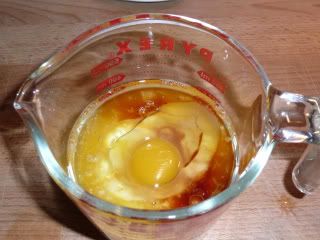

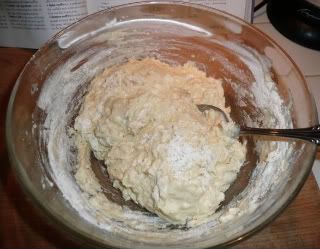 Dump all of the wet ingredients on top of the dry ones and mix until it looks like you need to stir it 5-6 more times.
Dump all of the wet ingredients on top of the dry ones and mix until it looks like you need to stir it 5-6 more times. But don't.
The batter will look lumpy and will feel sponge-y (that's the baking powder and baking soda creating bubbles).
This is perfect. If you overmix the dough, you'll get lop-sided muffins with tunnel-like bubbles in them.
As Alton Brown would say, "that's not Good Eats". [...moment of nostalgia for cable...]
Gently fold in your blueberries, being careful not to squish them.
Spoon the batter into muffin tins coated with cooking spray, place in a pre-heated oven, and cook for 18 mins.
While the muffins are cooking, make yourself a pot of tea. I prefer a basic black English breakfast tea, myself.
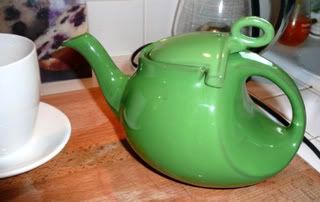
Grab a muffin, a spot o' tea, and the newspaper and head for your favorite spot in the house.

This is my kitchen nook and the window looks into a giant French lilac.
You can barely make out the bird feed that's mounted about 12 inches outside the window. We call it kitty porn.
Now, if you'll excuse me, I have a date with a very handsome boy.
COOKING LIGHT BLUEBERRY-YOGURT MUFFINS
2 cups all-purpose flour
1/3 cup sugar
1 t baking powder
1 t baking soda
1/4 t salt
1/4 c orange juice (or lemon juice, or buttermilk)
2 T vegetable oil
1 t vanilla extract
1 cup or an 8-oz carton of yogurt (or a creamy dairy thing or some sort)
1 large egg
1 cup fresh or frozen bluberries
Cooking spray
1. Preheat oven to 400 degrees.
2. Combine all dry ingredients in a large bowl and mix with a fork.
3. Combine all wet ingredients in a measuring cup and mix with a fork.
4. Dump wet into dry and stir until just barely incorporate. Do not overmix.
5. Fold in blueberries.
6. Spoon batter into muffin tins.
7. Bake for 18 mins or until wooden pick comes out clean.
8. Remove muffins immediately & cool on a rack.
9. Enjoy muffins with tea, a newspaper, and the company of a cat.
----------
LOCAL ingredients: yogurt, egg, blueberries
Friday, March 12, 2010
Slow food movement
 Quiz night! Slow Food is:
Quiz night! Slow Food is:A) What happens when your diet is deficient of fiber
B) French for "escargot"
C) The result of pissing off your waiter
D) What obese lions eat
E) A non-profit, eco-gastronomic member-supported organization that was founded in 1989 to counteract fast food and fast life, the disappearance of local food traditions and people’s dwindling interest in the food they eat, where it comes from, how it tastes and how our food choices affect the rest of the world.
I've heard about Slow Food for years but have never once researched it or sought it out. Some locavore I am, right? I've just known that I'm a Slow Food type of person. I make a majority of our food from scratch and enjoying doing so. I once took some homemade lasagna, which contained homemade pasta, to a friend. He asked "why would anyone made their own pasta".
My first answer was that we have 9 chickens and making pasta is a great way to use up 9 eggs at once. The second answer was "because I can".
I still kind of struggle with a clean, easy answer. I lean toward smartass remarks when cornered, so being flippant is easy. Sometimes being earnest is far more difficult.
Why do I make pasta (or yogurt, or bread, tomato sauce, or whatever) from scratch?
Because it's about as fresh as it can be.
Because I can pronounce all 4 ingredients: semolina flour, eggs, salt, water.
Because the eggs were raised humanely in my own back yard from hens who have names.
Because making things from scratch is a way for me to do something special for you that few others would bother doing.
Because I consider it a form of cheap entertainment.
Because you can't eat World of Warcraft.
Because I was avoiding laundry.
The Slow Food philosophy
We believe that everyone has a fundamental right to pleasure and consequently the responsibility to protect the heritage of food, tradition and culture that make this pleasure possible. Our movement is founded upon this concept of eco-gastronomy – a recognition of the strong connections between plate and planet.
Slow Food is good, clean and fair food. We believe that the food we eat should taste good; that it should be produced in a clean way that does not harm the environment, animal welfare or our health; and that food producers should receive fair compensation for their work.
We consider ourselves co-producers, not consumers, because by being informed about how our food is produced and actively supporting those who produce it, we become a part of and a partner in the production process.
Thursday, March 11, 2010
Here fishy, fishy
 What comes to mind when you think of the Pacific Northwest?
What comes to mind when you think of the Pacific Northwest?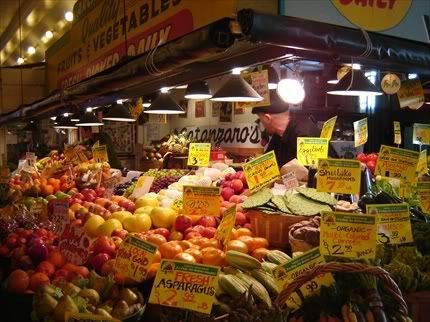
I think of the natural beauty of the mountains, sea, and forests, as well as iconic landmarks such as the Space Needle, Pike Place Market, Tacoma Dome, and Mount Rainer. Maybe those dorky, but spot-on, Pemco commercials?
Perhaps you think of coffee. This is a picture of a latte I got at the Mandolin Cafe a while back.

The PNW without seafood is like a Washingtonian without a fleece jacket. right?!?
So you'd think.
Last night decided to stop by Albertson's because I had a hunkering for some good old PNW fish.
The shrimp came from Bangladesh, Indonesia, and Thailand. The salmon - talk about the epitome of PNW foods - was Atlantic farm-raised with color added. Bleh. The clams were from Manila... 6,590 miles away.
There were other types of fish is display: tilapia from South America, lobster from god-knows-where, catfish nuggets from the USA, and rockfish from Canada.
I settled for the rockfish but not until I'd had a conversation with the meat counter employee. She seemed to share my chagrin that there were no local seafoods available. She offered to special order things "from a local seafood company" (I'm betting she means Johnny's).
I did learn a couple of things from our discussion:
- Talk to the staff at your local grocery store. Let them know that you don't want the imported seafoods: you want locally-sourced products if possible. They're in the biz and can offer suggestions but if enough people ask about local fish, they'll eventually pass it along to a manager.
- Find out when things are in season. I learned that local shrimp, or at least USA-caught spotted shrimp, are a seasonal item and will be available this summer. I didn't know that. Meats have seasons, just like produce: chicken is best in the summer and beef is a winter "crop".
- Go to the source. Johnny's, and probably other fishmongers, has inconvenient hours if you work a normal business day. But if I want locally sourced fish, that's where I have to go.
---------
One Washington product that's easy to find in abundance any time of year is wine. And thank god for that!
Paul Zitarelli is the owner of Full Pull Wines and a Foster MBA alumnus. He travels Washington State, seeking unique offerings of our state's best wines.
Get on his mailing list, drool over the descriptions, and stop by for a chat and a tasting. I had bought a sparkling wine a while back and dropped in to pick it up this afternoon.
Nothing perks up a rainy Thursday afternoon like an impromptu wine tasting.
Today Paul was offering a library of 2004-2006 cab sauvs from Couvillion Winery. I had an interesting talk with Paul and his friend, Darren, about local foods. God, I love foodies!
Darren, if you read this, here's that link about the Tacoman woman who makes empanadas that I mentioned.
Tuesday, March 9, 2010
Slow food fast

 Maybe I could hit the supermarket deli.
Maybe I could hit the supermarket deli.But then I'd have to park, stand in line at the counter, order up something fried that's been sitting under a heat lamp forever, get in line again, and dig through my wallet for money. By the time I got home, the fried dinner would be soggy and lukewarm.
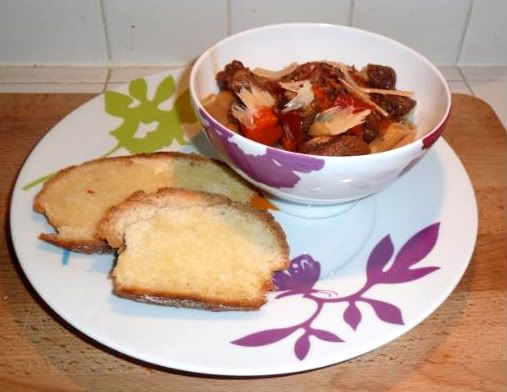
- Beef in red wine sauce, canned 2008. Guess it was time to eat that, eh?
- Organic whole wheat penne pasta from Trader Joe's
- Romano cheese
- Homemade bread, made & frozen 2 weeks ago
- Wine. Because it's Monday night. So what.
Sunday, March 7, 2010
What's more local than your own yard?
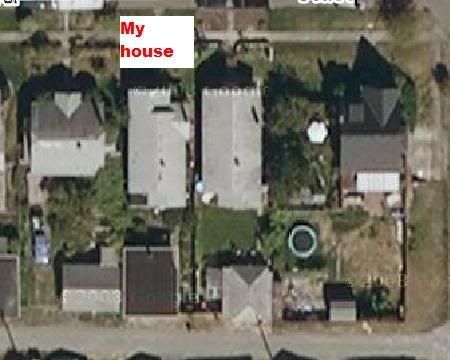 Our lot is, according to city records, 4,440 square feet. Once you account for the house's footprint, the garage & carport, walkways, chicken run, existing flower gardens, and shady areas, there's not much left for food gardening.
Our lot is, according to city records, 4,440 square feet. Once you account for the house's footprint, the garage & carport, walkways, chicken run, existing flower gardens, and shady areas, there's not much left for food gardening.In fact, the backyard has an area roughly the size of a parking space. Its location right outside the back door is perfect for a small kitchen garden. The plot doesn't get full sun all day. After 2 years of trying, I've given up trying to grow heat-loving things like eggplant, artichokes, and corn. Past successes have included all varieties of greens, carrots, tomatoes, yellow squash, and cukes.
At the suggestion of our friends Margaret and James, I t
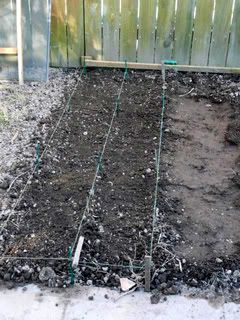 ried square foot gardening last summer. I liked the high density plantings to maximize the area and am going to keep using the methods, altered to fit my space. Last weekend I did some test plantings of climbing peas, bush peas, broccoli, chard, spinach, and green onions. All those plants are in the area you see in the pic. I'll probably try groups of three foot-wide rows with a pathway in between.
ried square foot gardening last summer. I liked the high density plantings to maximize the area and am going to keep using the methods, altered to fit my space. Last weekend I did some test plantings of climbing peas, bush peas, broccoli, chard, spinach, and green onions. All those plants are in the area you see in the pic. I'll probably try groups of three foot-wide rows with a pathway in between.I've never planted this early, and any peas that have sprouted in the past have always been anemic. Here's to hoping that a new location and earlier planting will bring better results.
I have two little problems. Scooter and Beaker have figured out how to escape the chicken run. The vast expanse of fresh dirt filled with juicy worms was just too much for them to ignore. What sprouts they don't eat, they'll step on or dig up.
We'll have to figure out a way to prevent the criminals' (Gene's term) escapes. I put an old window screen over the planted area to protect it from fowl intentions (heh) and the upshot is that the screen protected the seeds from last night's frost.
When I first bought the house I planted flower beds on the front yard's slopes because I hated mowing the hills. This spring I'm going to rip out the plants I don't like and transplant the ones I do to the left side of the stairs.
On the right side I'm going to plant perennials like asparagus, strawberries, and herbs, and root vegetables such as onions and garlic. I figure that the perennials will be attractive year-round - a plus for the neighbors - and that the root vegetables will not draw attention from passers-by who might be tempted to pluck a ripe tomato or broccoli head.
If you've driven by my house recently, you know that I've got my work cut out for me.
A locavore reality check
But we can always do better.
One thing I've realized of late is that while I put a ton of effort into canning, I'm not as good about using the things I've made. Or maybe I was impractical in my planning. Did I really need to make pickled roasted peppers? We're not eating them, so the answer is "no". Just because peaches are on sale doesn't mean that I need to rush out and make peach jam, which Gene doesn't even like. I'll be evaluating my canning priorities over the next growing season.
Last Friday we were in Poulsbo and needed lunch. We stumbled upon Central Market and were stunned that there was this awesome, Whole Foods-like grocery store.
In Poulsbo!
In the bakery there was this guy assembling packages of freshly made, whole wheat tortillas, which had to go home with us.
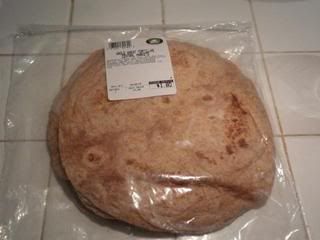
They were still warm. Yummmmmm.
Once back home, I raided our pantry to find that we had the makings for Spanish rice.
Home-canned tomatoes and beef broth:
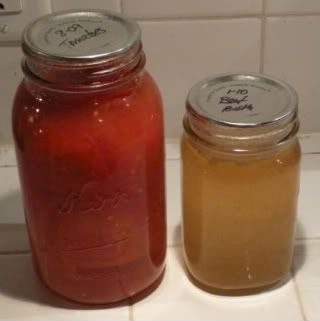
A massive store-bought onion and one of the puny ones from my garden (can you even see it on the right?):
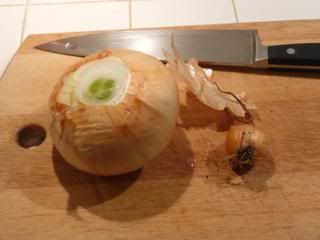
plus some rice, olive oil, garlic, and salt.
It tasted really good, despite being made with jasmine rice (the only white, long-grain rice I had in the house. I wondered why I don't make it more often, it's so simple. The green specks are parsley flakes, since I didn't have any fresh stuff.

I sauteed half of the massive onion with some red bell peppers I'd frozen last summer and the rest of the tomatoes.
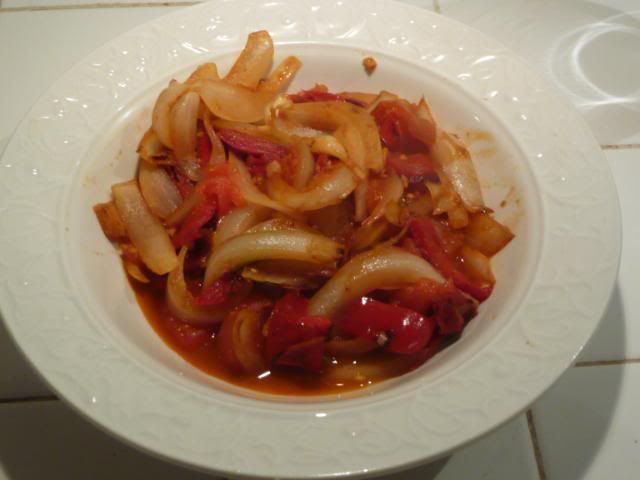
I had some beef that I'd gotten on clearance at Safeway. Oh yeah, I bought it the day before we watched "Food, Inc.". Talk about feeling guilty! Oh well. There's nothing I could do about this particular piece, other than rub it down with garlic, salt, pepper, and cumin before giving it a good sear.
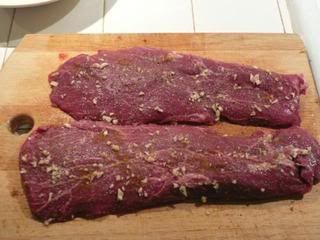
On a whole, we're eating semi-locally. Most of the time, at least 2 ingredients of any given meal can be considered "local". Here's the ingredient break-down of Friday night's dinner:
- WA STATE: Onion, tomatoes, beef broth
- NOT LOCAL: Beef, rice, onion, red peppers, sour cream, lime
- UNKNOWN: Garlic, tortillas
In conceptualizing this blog, however, I've realized that we're going to have to start putting our money where our mouths are. I felt guilty about preparing CAFO meat. I can't remember where the onion & garlic came from. Do the tortillas count as local just because they were made in Poulsbo? What about the sour cream from German-owned Trader Joe's? Who the heck knows where it's from.
Those are the types of questions I'll address in posts to come. I look forward to your thoughts about what's "local" and to hearing how you deal with it in your own life.


